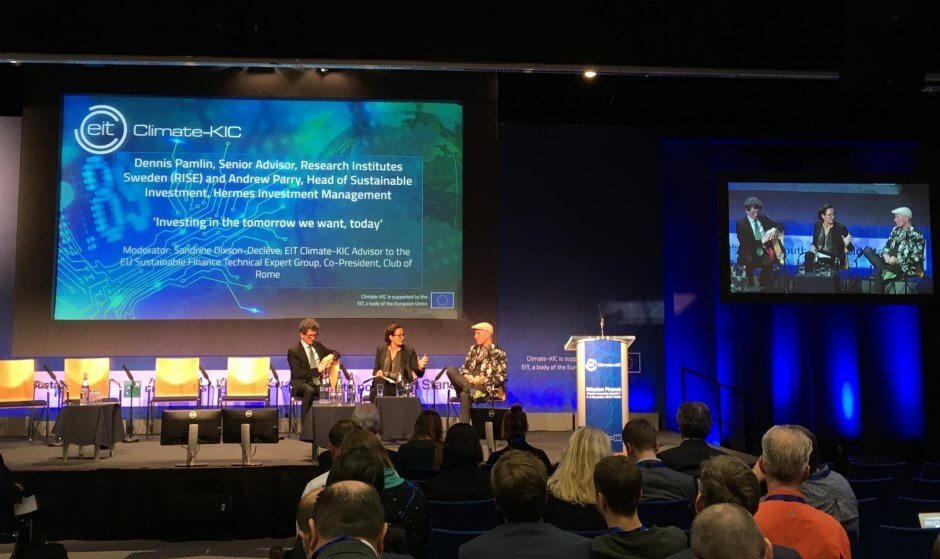Reframing perspectives on climate change

Where should investors be putting their money to make a real impact when it comes to climate change? And how should businesses react? Shifting the perspective from risk to opportunity can create an unexpected leverage point that could present the answer.
The plenary session on the second day of the Climate Innovation Summit in Dublin put climate change impact at the heart of financial discussions. Dennis Pamlin, Senior Advisor at Research Institutes Sweden (RISE), and Andrew Parry, Head of Sustainable Investment at Hermes Investment Management shared their forward-looking perspectives on how to reframe our current understanding of climate change, and how to foster discourse that speaks the language of investors.
Facilitated by Climate KIC advisor to the EU Sustainable Finance Technical Expert Group Sandrine Dixson-Declève, the speakers set the frame by emphasising how we tend to treat climate change as an environmental issue; as a risk matter on the side, as nothing more than CSR:
“It gets grouped into the weakest department of the company and comes in as the last part of discussion, often grouped together with other environmental issues. But it’s not. Climate change is an existential threat, yet 99 per cent of society do not frame it as such,” Dennis Pamlin said.
Andrew Parry followed up on this statement by linking it to an investment perspective:
“We need to rethink impact to encourage the creation of impact-enabled business models. Not as a linear way of solving problems but by putting impact at the heart of business models. Everyone talks about ESG but that is so 1990s. You must instead start to think about sustainability. It is forward-looking. Don’t think about the portfolio but rather about the components of the portfolio
He continued: “For people coming into the field, there are a lot of acronyms and differing opinions. It’s messy and complicated. This is challenging for finance and investment-orientated people who are used to looking at an index.”
Both speakers agreed that the current climate change benchmark tends to be rooted in the structure of the past:
“The need for reduced emissions is often based on an assumption that the current system is the one we should have. We talk about how we can reduce emissions and how to set reduction-based emission targets in the existing system. Often that does not help us create the tomorrow that we want. Most current frameworks are based on yesterday’s world, for instance, reporting systems. We are still asking the big polluters to take small steps,” Pamlin explained.
In the context of pension fund investments and the challenges of sustainability versus current structure, Andrew Parry shared the following perspective:
“They blame it on QE. It is hard for pension funds to integrate sustainable investments because they have to reach their 4 per cent inflation rate. Why are pension funds not doing more? Because they are constrained by the current structures in place, so they have to make a minimum return.”
By reframing our current narrative about climate change and situating it in a context of opportunity rather than risk, it can become something that increases human well-being rather than coming at the expense of it.
“Climate change is perceived as stopping something, not creating it. But there has been a dramatic change in costs for key environmental technologies and new transparency tools are now possible. The Overton window is moving very fast. Being rational is being stupid, it is being short-sighted and looking back,” said Pamlin.
So how do we advance the discussion and translate words into action? And how do we incorporate the business perspective?
“We need to reframe the question about how we interact with companies. If you frame sustainability and climate change as fear, you lose them. It must be framed in terms of how we make money. SDGs are a way of reframing the conversation. Make it context-based. Frame it in terms of a better way to invest and disclose,” said Parry.
Pamlin followed up with his perspective:
“We must be much bolder and reach out to those who have not been part of the discussion before. There is no silver bullet to this. We must bring in a broader focus and let the ideas flourish. We should have at least five scenarios that are possible, not just one to bring us forward. It should be on the front page, in the legal pages and on the finance pages.”
In conclusion, both speakers shared their final remarks on how to keep on progressing:
“Doing more with less will only create incremental solutions. We must rethink the entire process. Everyone is a part of this transition, all hands on deck, we need that. Many of the people that are good at talking are not necessarily good at action”, said Pamlin.
“My biggest fear about a lot of the greatest things we are doing in Europe is the sustainability arbitrage. Many look at this with a short-term lens, a Milton Friedman approach. We have to make sure that we carry the voice of the world to change the system. We cannot do this in isolation,” said Parry.
With the carbon costs of travel in mind, Climate Innovation Summit session summaries are available online for those who cannot attend—and for review for those present. These summaries aim to extract the key debates, dialogues, and learnings from each #MissionFinance session.
